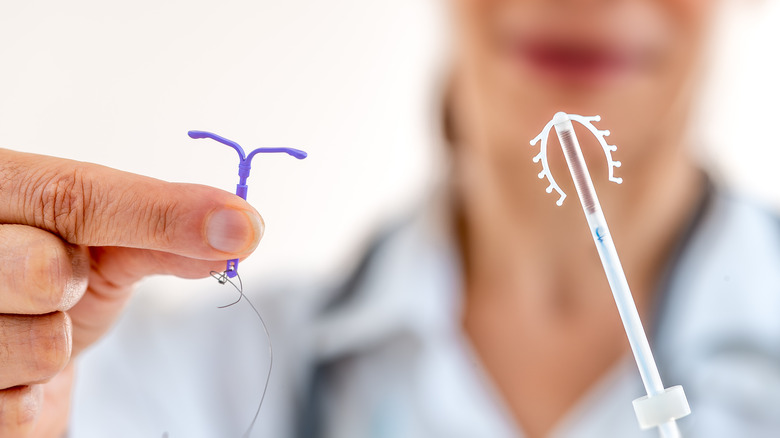How To Tell If Your IUD Is Out Of Place
An intrauterine device, or IUD for short, is a type of birth control that comes in the form of a small T-shaped device that is placed at the opening of the cervix (per WebMD). For women who don't want to bother with having to take a pill at the exact same time every day, an IUD can be extremely convenient, especially since some IUDs can last up to a decade. With an IUD properly positioned, the chance of becoming pregnant is less than 1%. In addition to being hassle-free on a daily basis, IUDs are rarely able to be felt, so you'll likely never even know it's there most of the time. On the flip side, you'll want to regularly check that your IUD is still present and properly positioned.
So how do you know if your IUD has gotten out of place? You should perform regular self-checks to make certain that you can feel the strings of your IUD, and you'll want to have your doctor check the positioning during your annual exams. Although it's very rare, IUDs can migrate, fall out, or twist (via PopSugar). If you can't feel the strings of your IUD, or if you experience symptoms that could indicate that your IUD isn't where it should be, you should make an appointment with your doctor ASAP.
Symptoms of an erroneous IUD
Knowing the ins and outs of how an IUD's positioning might change can help you become informed about what to expect if something goes awry. Doing regular checks of your IUD strings and suddenly noticing that the strings are a different length may indicate a shifting IUD, says WebMD. Symptoms of an IUD being in the wrong place include cramping, abnormal bleeding or spotting, foul-smelling, unusual discharge, and abdominal pain. Heavy bleeding, intense pain, or fever can indicate an infection or serious situation, and immediate medical attention should be sought.
There are a few ways that IUDs can get out of place. Again, it's extremely rare, but an IUD can twist out of position from vigorous cramping or improper initial placement (per PopSugar). The quarter-sized device can migrate if it becomes dislodged and travel elsewhere in your uterus, even perforating through the walls of the uterus. While this may sound like your worst nightmare, the risk of it happening is only about one in 1,000. If your IUD becomes dislodged but doesn't travel upwards, gravity may take hold and you might feel the device shift downward, and in extreme cases, it may even fall out. Don't ever attempt to readjust your IUD or put it back in place as doing so can cause tearing and damage to very sensitive tissue, and never try to remove your own IUD. Instead, always let the professionals, aka your doctor, handle the repositioning of IUDs.
Risk factors for a dislodged IUD
While anyone with an IUD is susceptible to something going awry, there are factors that increase the risk of an IUD shifting out of place, reports Healthline. These include actively breastfeeding, having a tilted uterus or small uterine cavity, and having the IUD inserted directly after giving birth or by a practitioner inexperienced in IUD placement. Age is another factor, with women in their teens being more likely to experience IUD mishaps. Having intense cramps, or uterine contractions can also raise your risk of an IUD dislodging. A 2016 study published in the Open Access Journal of Contraception found that perforations from dislodged IUDs are due to frequent tearing of the surrounding tissue during insertion or to gradual tearing of tissue following improper IUD placement. The latter is termed "secondary perforation" and happens when a small tear occurs during the insertion of an IUD that continues to tear over time. Be mindful of any symptoms you experience following insertion and let your doctor know if you have concerns.
When you first have your IUD inserted, you might experience cramping, which is referred to as IUD cramping, according to WebMD. As your body adjusts to having an IUD inside of it, the cramping can continue for several weeks. However, if the cramping doesn't subside within three months, you should consult with your doctor as it could indicate improper placement of the IUD, especially since severe cramping can increase the risk for a dislodged IUD.



